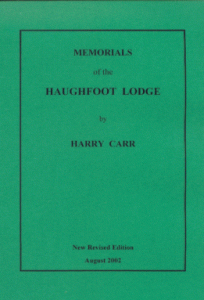Memorials of the Haughfoot Lodge
by Brother Harry Carr.
This edition published and edited by Brother Trevor Stewart. August 2002.
£7.00 per copy (plus post and packing) from the Grand Lodge of Scotland.*
 The late Brother Carr (1900 – 1983) was an erudite and prolific author on matters relating to Freemasonry. He is best remembered, in Scotland, for his work on, for example, the records of Lodge Mother Kilwinning, No.0 and the Lodge of Edinburgh (Mary’s Chapel), No.1.
The late Brother Carr (1900 – 1983) was an erudite and prolific author on matters relating to Freemasonry. He is best remembered, in Scotland, for his work on, for example, the records of Lodge Mother Kilwinning, No.0 and the Lodge of Edinburgh (Mary’s Chapel), No.1.
His work on the Haughfoot Lodge is important if for no other reason than that it was not until the work of Prof. David Stevenson were the records re-examined – and then only as part of a much larger study. This edition of Brother Harry’s work is a most useful edition to any Masonic (and indeed non-Masonic) historian’s bookself especially because, until now, this work has not been available as a separate text. Our thanks are extended to Brother Stewart, Past Master of Quatuor Coronati Lodge, No.2076, for making this available at such a modest cost.
It is a matter of some concern that the type of Masonic scholarship demonstrated by Carr, Stewart and Stevenson appears to be in decline – how so? In observing the material available in the public domain, produced by a variety of popular writers, it is clear that they have not examined the primary source material such as the Sederunt Books of the Haughfoot Lodge. Of even more concern such authors do not appear to have even considered the research of authors such as the late Brother Carr. With the availability of his work on the Haughfoot Lodge there is no excuse for writers on Masonic history not to make use of his work.
Why is this particular Lodge so important in terms of the history of Freemasonry? Most Masonic historians take 1717 as the year from which Freemasonry, as we know understand the term, to have come into existence. Whilst it is acknowledged that prior to 1717, in Scotland, there existed Lodges the membership of which comprised solely of stonemasons as well as Lodges of stonemasons with a few non-stonemasons as members, purely ‘speculative’ Lodges did not exist until 1717, in England. That position has been argued about in detail elsewhere (particularly within the pages of Quatuor Coronati Lodge’s annual journal A.Q.C.**) but the Haughfoot Lodge is the ‘fly in the ointment’ for that particular view of Masonic history. Why?, because in 1702, in the borders of Scotland (about 20 miles south of the capital) a Lodge was created by local lairds and there were no stonemasons involved. In other words this is the first known purely ‘speculative’ or modern Masonic Lodge in existence. One can perhaps now appreciate why the Haughfoot Lodge is so important in the origin and development of Freemasonry and it all the more puzzling why popular authors have completely ignored the existence of this first modern Masonic Lodge.
Brother Stewart, in editing Brother Carr’s work, has completely re-edited, re-formatted and amalgamated the material to form a continuous sequence. In this he has provided a great service.
In order to commemorate the creation of the first purely ‘speculative’, non-operative, or non-stonemasons’ Lodge, (a discussion of these terms will be found elsewhere in this site) a new Haughfoot Lodge was consecrated 300 years later.***